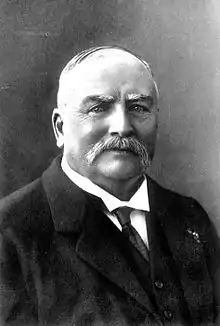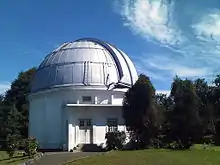Karel Albert Rudolf Bosscha
Karel Albert Rudolf Bosscha, sometimes known as KAR Bosscha or Ru Bosscha (The Hague, 15 May 1865 – Malabar, Indonesia, 26 November 1928) was a planter, philanthropist and administrator of the Malabar Plantation in Bandung, Indonesia.

Life and work
K.A.R. Bosscha was the son of renowned German-Dutch physicist Johannes Bosscha and Paulina Emilia Kerkhoven. After gaining some formal education in engineering at Polytechnical School of Delft, in 1887 came out to Netherlands Indies and stayed with his uncle while working at Sinagar Estate near Cibadak (West Java) that his uncle owned. Work at his uncle's company gave him little satisfaction, thus after six months he went to Sambas (Borneo) to join his older brother John Bosscha, a geologist. During this time he worked on gold exploration and mining with his brother until his return to Sinager 1892, this time as its administrator.[1] He stayed at Sinagar Estate until 1895 and in 1896 he undertook the management of Malabar Estate near Pangalengan (Bandung) until his death in 1928. As of 2011 the Malabar Estate plantation is still operational under state own company (PT Perkebunan Nusantara) management.
Little was known about his personal life. He never married.
K.A.R. Bosscha spoke Malay, Sundanese and Javanese very well. He was also reported to speak Sundanese fluently.



Philanthropy
K.A.R. Bosscha was also a philanthropist and continued his family's traditional interest in science. He most notably participated in the development of the Bosscha Observatory (Bosscha Sterrenwacht) in Lembang near Bandung in 1923.[2] His contribution consists of land that is now used as its location and as the main benefactor until the project's completion five years later (1928). He also sponsored the purchase of the telescope itself from Carl Zeiss of Jena.[1]
Today, the observatory belongs to the Department of Astronomy, Bandung Institute of Technology and it is named "Observatorium Bosscha" (Bosscha Observatory). Indonesian prominent astronomers and physicists have trained there during their early educations.
Bosscha also helped the development of the Cancer Center in Bandung (het Nederlandsch-Indisch Kanker Instituut) and the Technische Hoogeschool te Bandung in 1920[3] now known as Bandung Institute of Technology. He also created an (free of charge) elementary school for his workers' children in 1901 known as Vervoloog Malabar, now known as Malabar 4'th Public Elementary School (SD Negeri Malabar 04). While the original building partially burnt down, the school now has modern (brick and cement) buildings. The remaining building now serves as a museum. It is made of wood, with bamboo sheet wall.




For his work and contribution to the society, he was awarded honorary citizenship of Bandung. An asteroid (11431 Karelbosscha) was named after him in 1971.
References
- Pyenson, Lewis (1989). Empire of reason: exact sciences in Indonesia, 1840–1940. Empire of Reason. 13. BRILL. p. 194. ISBN 978-90-04-08984-6.
- "Bosscha Observatory - History Archived 5 February 2011 at the Wayback Machine"
- "Bandung Institute of Technology - History Archived 13 April 2011 at the Wayback Machine
